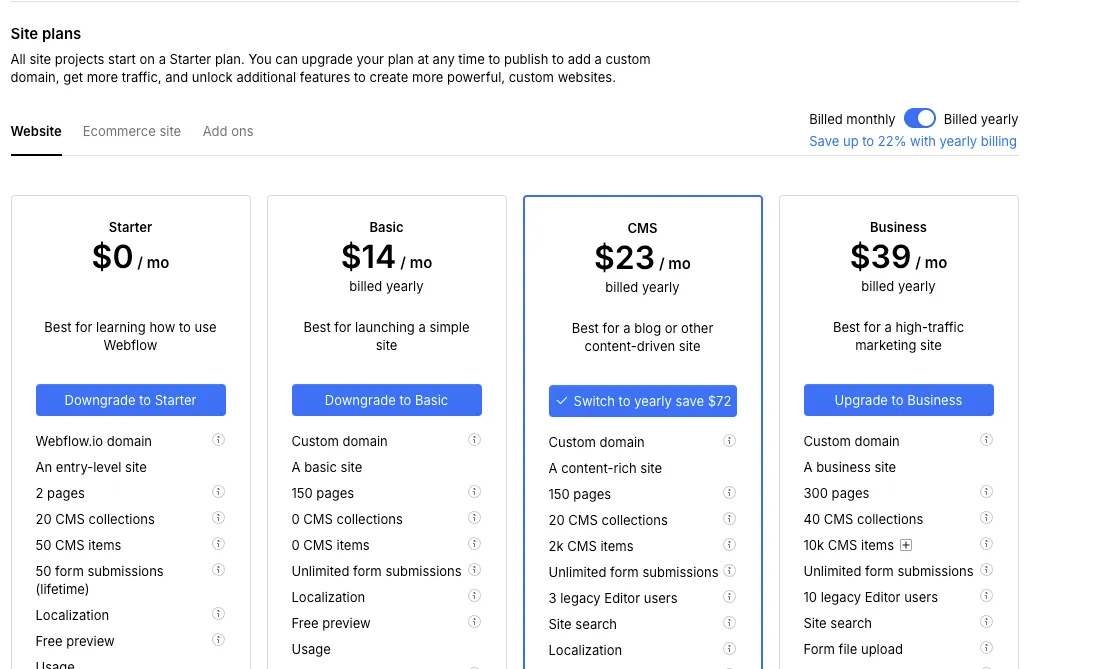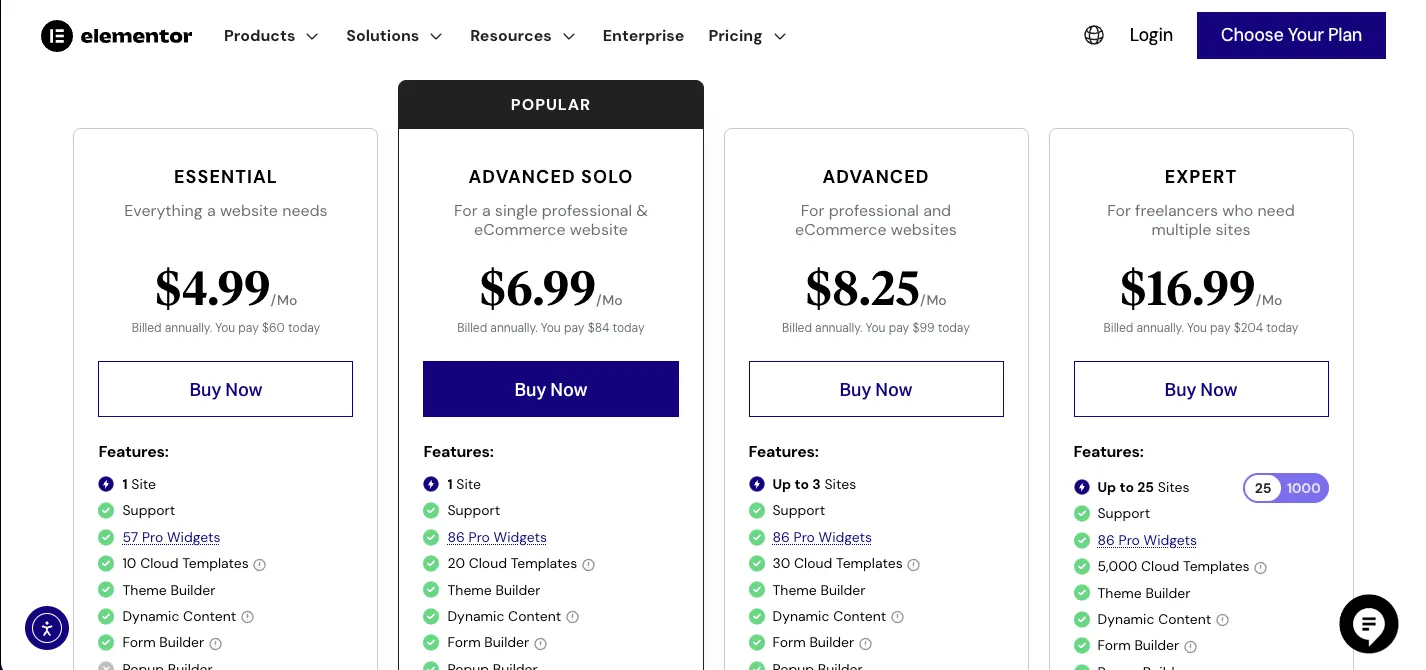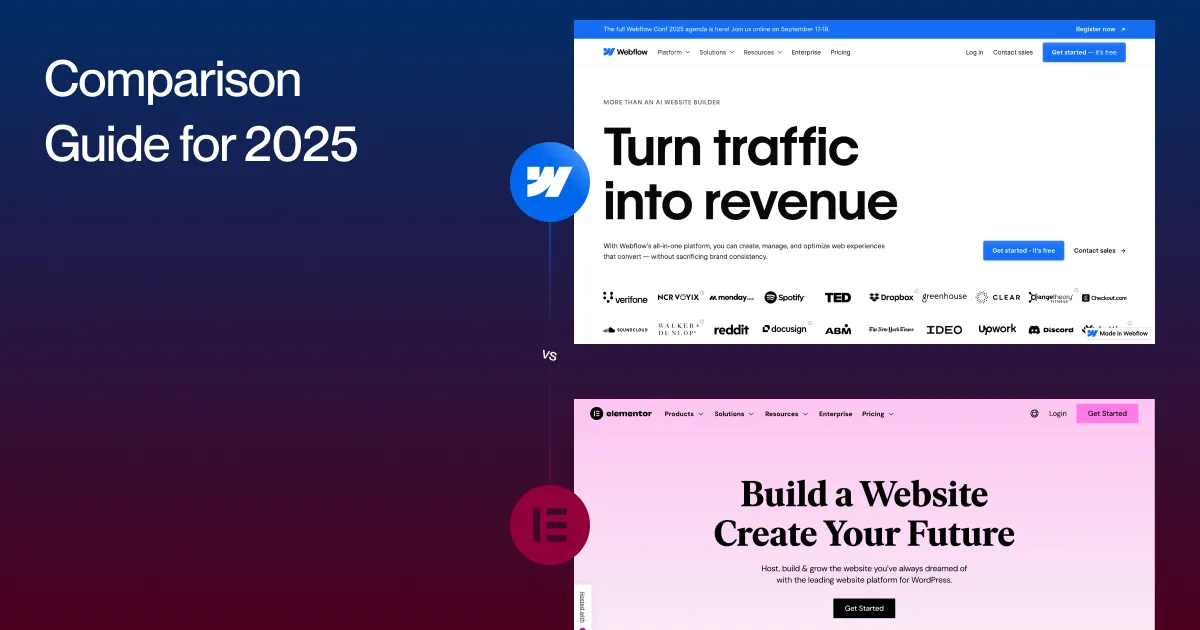Every day, the number of web builders is growing but two names consistently stand out: Elementor and Webflow. Both offer a fast and efficient way to build a modern website without coding from scratch. But which one should you choose?
The difference between them can mean having a website that grows with your business or one that holds you back.
In this blog, I’ll compare the two, outline their pros and cons, and share insights on usability, pricing, and SEO based on my hands-on experience with both.
By the end of this post, you’ll have a clear idea of which web builder best fits your needs.
What is Webflow?
Webflow is a platform that allows you to design, build, and host your website all in one place. It gives you complete control over your site’s design and functionality — without requiring any coding knowledge.
What makes Webflow stand out is that it generates clean, efficient code behind the scenes while you focus on the visual design. For experts, it’s pure gold — powerful websites with minimal effort.
And it’s more than just a design and development tool; Webflow is also a CMS and e-commerce platform.
Pros:
- Complete design flexibility and precision
- Free plan with unlimited use of Webflow Designer and Editor
- SEO-friendly features built directly into Webflow, with no extra integrations needed
- Easy-to-use CMS and dynamic content
- No need for external hosting or security management
Cons:
- Limited e-commerce features compared to Shopify or WooCommerce
- Steep learning curve for beginners with no web development experience
- More expensive than WordPress, especially for small businesses
What is Elementor?
Elementor is one of the most popular WordPress plugins that allows you to build custom websites with a drag-and-drop interface. It works with any WordPress theme and offers a wide range of features such as widgets, animations, popups, and much more.
It’s a great choice for beginners and WordPress users who want to enhance their website presence and performance.
Pros:
- Easy for beginners with a drag-and-drop system
- Huge number of plugins that can be easily integrated
- Very affordable pricing, with a free version also available
- Vast number of tutorials, forums, and online resources
Cons:
- Poor performance if too many additional plugins are used
- No built-in SEO advantages; you rely on extra tools (e.g., Yoast)
- Occasional conflicts with other plugins and themes
Webflow vs Elementor – Easy to use
Webflow is powerful, but it helps to have some development experience to make everything run smoothly. That said, their YouTube channel offers plenty of tutorials, and there’s a strong community ready to help you learn everything you need.
Once you’ve mastered what’s necessary, Webflow becomes unbeatable in flexibility and control over website creation — and it will quickly become your number one tool.
Elementor is known for its drag-and-drop interface, making it an excellent choice for beginners and those entering the world of web development. You can see your changes in real time and preview how your site looks on different devices.
It also offers a variety of widgets you can add to your site, such as buttons, contact forms, sliders, testimonials, and more. No coding knowledge is required, but it also gives you the option to add your own code if you want advanced features.
Compared to Webflow, it is definitely easier to use for beginners.
Winner: Elementor is easier to use, especially for people who are new to development.
Webflow vs Elementor – Design Flexibility
Webflow is widely adopted because it offers unlimited creative freedom and design flexibility. It gives you full access to front-end power without touching a single line of code. The tool transforms all your designs into semantic, clean code. From creating responsive layouts to implementing complex animations, Webflow is definitely the go-to choice for creators.
Like most web builders, you can start a project from scratch or use pre-made templates. What sets Webflow apart is that templates don’t limit your creativity. You can edit and modify every element down to the smallest detail. There’s also a showcase section where you can clone projects for free from other creators — either to adapt them to your needs or to learn how they were built.
Elementor is also great in terms of design flexibility, offering over 300 templates and 90 widgets, allowing you to build a site that perfectly matches your needs and vision. What stands out are the Flexbox containers, which help you create complex and responsive layouts easily.
Winner: Webflow is still more flexible thanks to its blank canvas approach, compared to Elementor’s impressive customization options.
Webflow vs Elementor - Pricing
Webflow offers various pricing options, divided into three main categories.
- Site plans are best for simple, content-based websites.
- E-commerce plans are best for online stores.
- Workspace plans allow you to work on multiple projects as a developer and collaborate with large teams.
Webflow allows you to build a complete website for free before deciding to go live. You can test your site as much as you want before publishing it.
Site Plan - Explanation
- Starter (Free) – Includes a webflow.io domain. New users start with this plan which has limited features. You can create up to 2 pages, will have their badge (Made in Webflow), and cannot export the code.
- Basic ($14 per month) – Includes a custom domain. Up to 150 pages, 10GB bandwidth, and free SSL certificate. (Perfect for a simple site.)
- CMS ($23 per month) – Includes a custom domain and up to 150 pages. Supports up to 1,000 contact form submissions per month, 3 content editors, site search, 50GB bandwidth, 2,000 CMS items, and 20 CMS collections. (Ideal for slightly more complex sites needing CMS content.)
- Business ($39 per month) – Includes a custom domain and up to 300 pages. Supports unlimited monthly submissions, advanced global CDN, 10,000 CMS items, 100GB bandwidth, and site search. (For advanced sites with lots of content.)
- Enterprise – Pricing and features must be discussed directly with Webflow.

All of these prices are billed annually, and you can save 22%.
E-commerce Plan - Explanation
- Standard ($29 per month) – Includes a sales volume of $500K, 2% transaction fee, integrated CMS for blogs with 500 items, and email customization.
- Plus ($74 per month) – Includes up to 5,000 items, 0% transaction fee, and all Business plan features.
- Advanced ($212 per month) – Includes up to 15,000 items, 0% transaction fee, and all Business plan features.

All of these prices are billed annually, and you can save 22%.
Workspace Plan - Explanation
- Starter (Free) – Includes creating 2 sites with a webflow.io domain, and you can have guests with Agency or Freelancer plans.
- Freelancer ($16 per month) – Includes 10 sites with a webflow.io domain, full access to client workspaces, and the ability to charge clients for hosting.
- Agency ($35 per month) – Includes unlimited site hosting with webflow.io domains, full access to client workspaces, the ability to charge clients for hosting, advanced roles, and requests.

All of these prices are billed annually, and you can save 33%.
Elementor also offers different pricing plans for the WordPress site builder, depending on the user’s needs. All plans are billed annually. However, it’s important to note that hosting for the website itself is paid separately and is not included with the Elementor plugin.
- Essential ($60 per year) – Includes 1 site, 57 widgets, Form Builder, dynamic content, and 10 Cloud templates.
- Advanced Solo ($84 per year) – Includes everything in the Essential plan plus Popup Builder, custom CSS code, and eCommerce features.
- Advanced ($99 per year) – Includes everything in the Advanced Solo plan and the ability to work on 3 sites.
- Expert ($204 per year) – Includes everything in the Advanced plan and the ability to work on up to 25 sites.

Winner: I recommend Webflow because it already includes hosting, SEO tools, and e-commerce features all under one roof. Elementor may be more afordable, but you also need to consider additional costs for hosting and other plugins.
Webflow vs Elementor - SEO
Webflow offers SEO features built directly into the system, such as clean code, fast loading times, customizable meta tags, schema markup, and recently, support for AI search engines with llms.txt (Check my latest blog if you need to sucessfully upload llms.txt to your site). All of this is available on the platform itself, with no need for additional plugins.
With Webflow, you have full control over site optimization, which is crucial for competitive industries. The platform’s speed and long-term performance help SEO, making it a top choice and prioritizing search engine visibility.
Elementor does not have integrated SEO functionality in the system, so you need to add an additional plugin. The most popular is definitely Yoast SEO, which allows you to customize metadata and URLs for your site’s internal structure. While very effective, it can sometimes complicate the process.
Winner: Webflow offers far more SEO capabilities and is easier to use.
Who should choose Webflow?
- Want everything in one place with full control over design and features
- Don’t mind paying a bit more for clean code, better performance, and built-in hosting
- Businesses with more complex needs
Who should choose Elementor?
- Those looking for a more economical option with a free start
- Beginners and small businesses who need simplicity
- Need a simple tool that works with any WordPress theme
Conclusion
Webflow definitely stands out for its flexibility and capabilities, while Elementor is easier for beginners, ideal for simpler projects, and works seamlessly with WordPress. If you’re new, start with Elementor; if you’re more experienced and have the skills, you should definitely try Webflow.
Both platforms are excellent options, but depending on your needs, choose the one that suits you best. If you’re still unsure which is the best choice for your website, I’m always available to help.
Have a brief? Let’s chat
Let's chat about your project, your needs, our expertise, our portfolio, and how we can join forces to create something cool!



